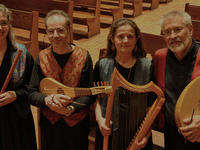
Ensemble for Medieval Music
Melos Amoris
Music from a mystical manuscript
Sine Nomine (founded in 1991) performs the vocal and instrumental music of Europe transmitted in manuscripts from the tenth to the fifteenth century. Concerts are structured around the music of a particular country, period, genre, or are thematically organized to allow for both depth of preparation and coherence in presentation. As historically-informed performance is best when evanescent sound is buoyed by learning worn lightly, so Sine Nomine strives to create a performance atmosphere both relaxed and informal, gently removing the barriers between audience and performer so often found in classical music.
Janice Kerkkamp, voice
Bryan Martin, voice and lute
Randall Rosenfeld, gittern and voice
Andrea Budgey, voice, rebec, and harp
with special guest David Roth, voice
NOTES
All text and music is from Oxford, Bodleian Library, Lincoln College MS Latin 89, unless otherwise noted. All Latin translations are by Andrew Albin.
This program is a collaboration with Fordham University English and Medieval Studies scholar Andrew Albin, who is currently a Senior Fellow at the Institute for Sacred Music at Yale University, and who was a Mellon Fellow at the Pontifical Institute of Mediaeval Studies (where SINE NOMINE is ensemble-in-residence) in 2011-2012. Dr. Albin posed an interesting question: He was studying an early 15th-century manuscript copy of Richard Rolle’s (d. 1349) Melos amoris, which happened to have some music appended to it at some later time. The musical section was unknown to musicologists until the 1970s, when it was transcribed by Ann-Marie Seaman at the University of Leeds. (Her transcription is the basis of our performing edition).
That two seemingly unrelated manuscripts would be joined together is not unusual; some of the music on tonight’s programme that does not come from this manuscript (known formally as Oxford, Bodleian Library, Lincoln College MS Latin 89) comes from sources with similar origins. Reasons for this may range anywhere from simple convenience to a change in function or ownership. In this case, however, a relatively cohesive body of devotional music was joined to a devotional text. Could it be that at some point the two parts were joined together because of some kind of thematic unity?
The nature of the collection of music raises its own questions. It appears to be part of a larger collection of liturgical music, or Kyriale, dating from the early 15th century, with some later additions, which include what appear to be musical “sketches”. It is heavily damaged in some places, presumably before the sketches were added, because some of them appear to have been written around the missing bits. The presence of several incomplete pieces (not due to damage) indicates that there are pages missing, and the presence of one part of a Gloria near the beginning of the musical section indicates that this page, at least, is out of sequence. What we have, then, is a collection of Kyries (the first of the “ordinary” parts of the Mass), a Marian antiphon, and the top voice of a Gloria (the second of the ordinary parts of the Mass), with a motet on a text from the Song of Songs and a monophonic carol in English added at a later time. If the music was specifically chosen to accompany the text, however, the presence of the incomplete Gloria might be a fluke, since it is on the reverse of the leaf containing the Marian antiphon, which is complete. Ultimately, we’re unlikely ever to have a completely satisfying explanation for the composition of the musical section.
We have augmented the material in our principal source with contemporary works in similar styles: settings of Descendi in ortum meum by (probably) Leonel Power and John Dunstaple, and a setting of another Song of Songs text, Qualis est dilectus by Forest (first name uncertain). We have also included two instrumental works (actually arrangements, or intabulations, of 14th-century French motets) from the Robertsbridge Codex, an English source roughly contemporary with Rolle, and have created our own intabulation of the incomplete Gloria. Where possible, other fragmentary pieces were completed from concordances in other sources (Plummer’s Descendi in ortum meum, and Power’s Kyrie Lux et origo). The carol Man assay includes only the first verse. We selected others from a two-part setting of what appears to be the same text in the Selden carol manuscript, and include that setting as well.
As for the question of thematic unity, as with so many others, it may never be answered conclusively. However, there is no shortage of parallels between the musical texts and Rolle’s richly alliterative Latin prose. Dr. Albin will share many of these with us tonight in his own evocative alliterative translation.